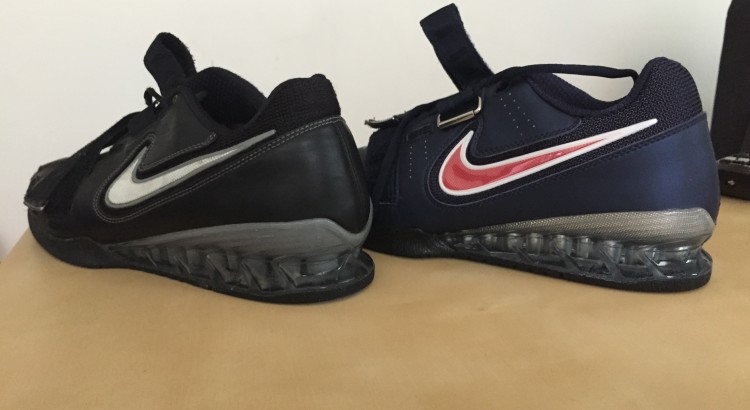In celebration of this week’s meniscus surgery and the hopeful return of “leg day,” I’m writing about weightlifting/squatting shoes. With the anticipation that I’d be working out again, I recently picked up my 2nd pair of my preferred squat shoes, Nike Romaleos.
Why weightlifting shoes?
Co-owner of my gym (SSPT) and innumerable time national/international champion powerlifter Sioux-Z Hartwig Gary recommends that rather than having an additional session of personal training with her, most new lifters would be better off spending the $100-$200 on a pair of lifting shoes.
A good weightlifting shoe will have a flexible flat forefoot that allows good feel, and a solid heel that allows direct power transfer between the lifter and the floor. Conventional athletic shoes tend to have too much cushioning and contoured soles, which can make them unstable under weight. Weightlifting shoes will also have an elevated heel, which allows for a less acute shin angle when at the bottom of the squat, as well as helping to keep the shoulder blades over the bar when pulling from the floor.
They’re pretty much a must for squats and the Olympic lifts. I find them more comfortable for benching, overhead pressing as well because of the added stability. If you’re serious about strength training, you should probably keep a pair in your gym bag. It’s no more ridiculous than buying a specific running shoe and custom insole for your stride pattern. Barrel Triathlon Team, I’m looking at you.
So… why Romaleos?
Back before 2008, Adidas was the only mainstream company that made weightlifting shoes. Everything else was off-brand and with dubious construction. Everything had a wooden heel. Nike introduced the Romaleos at the 2008 Olympics and really stepped up the game. These weightlifting shoes were made like real shoes, fit like real shoes and didn’t look totally ridiculous. Instead of a wooden heel, Nike used polycarbonate. Since then, pretty much all weightlifting shoes have copied the same model, including Adidas and smaller brands like Reebok, Do-win and Inov-8. Now that all the shoes are essentially the same, it’s all about brand loyalty, fit and fashion. My original pair have lasted me 4 years of 3+ workouts per week. I only bought a new pair so I could rock the sweet ‘Murrica colors.
In conclusion, if you don’t skip “leg day,” it might be time to start rocking a pair of weightlifting shoes.

Alex, can you point to any literature utilizing an RCT design that shows that weightlifting shoes improve gains or prevent injuries above and beyond just wearing regular shoes? And do you have any experience with strength shoes? I remember they were all the rage, way back when, for people trying to improve their vertical.
This is the classic video of comparisons for weightlifting shoes vs. conventional shoes:
https://www.youtube.com/watch?v=TrJfOi5rnlU
A quick google brought up these blog entries about elevated heels and shin/ankle angle:
http://trainuntamed.com/why-you-cant-squat-deep-2/
http://www.inthecave.com/blog/?p=8365
Basically, the elevated heel allows for a better position in the hole, especially for those who aren’t flexible enough to squat to the bottom. These can be useful in preventing lordosis at the bottom position.
As for absolute strength gains, I’m unaware of any official studies, but I’ve heard of 5-10% thrown around for the Olympic lifts. My roommate (a lifting coach) and I were discussing this. It’s really just safer for the added stability plus the better positions of leverage your body is put in. The strength advantage comes from the ability to securely drive off your heels. You can’t do that with a squishy sole that spreads as you push off. The same cushion that reduces impact when you run also reduces your ability to push off the floor.
I love using weight lifting shoes. So much more power in the gym now.
I’ve really been considering getting some myself lately… I’m hoping they’ll help reduce buttwink when I’m squatting.
Based on the available research on low to moderate intensity squats, it seems that Olympic shoes and heel lifts may help you improve squat form and in turn move more weight.